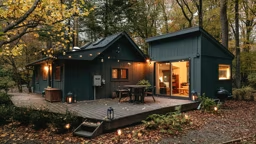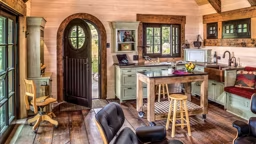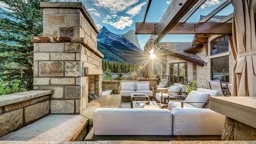Stone makes a timeless mantel. If you’re building an exposed stone fireplace, go ahead and use the same stone for a mantel. You can also coordinate a mantle with a stone countertop or kitchen island for a unified, custom look. Fieldstone, granite, tumbled marble, limestone, bluestone, sandstone, slate – the choice is yours. Of course, it’s hard to choose when they’re all so beautiful.
Go native. If you can’t decide which stone or species of wood is best for your place, go native. Indigenous elements always ground a cabin and bring the outdoors in. For instance, burled lodgepole pine heightens drama in a western cabin. An old stone fencepost speaks of a New England farmhouse’s past. Driftwood is perfect for a beachcomber’s getaway. Do you have standing dead timber on your site, or a tree fallen in a storm? Have a local sawmill recycle it into a mantel.
Go native. If you can’t decide which stone or species of wood is best for your place, go native. Indigenous elements always ground a cabin and bring the outdoors in. For instance, burled lodgepole pine heightens drama in a western cabin. An old stone fencepost speaks of a New England farmhouse’s past. Driftwood is perfect for a beachcomber’s getaway. Do you have standing dead timber on your site, or a tree fallen in a storm? Have a local sawmill recycle it into a mantel.
Design Tips
Part architecture, part furniture, a mantel links the fireplace with a cabin’s décor.
Coordinate. Repeat materials for flow and continuity, suggests Ward D’Elia, AIA, of Samyn-D’Elia Architects in Ashland, N.H. For example, D’Elia incorporated debarked cedar throughout a lakeside cabin he designed. A cedar mantel and brackets coordinate with cedar columns in the kitchen and screen porch.
Traditional or casual? The traditional “surround” has a top shelf and legs or columns that frame a firebox on three sides. Usually, a facing of tile, brick or stone fits between surround and firebox.
A “shelf” mantel is just that – a shelf or beam mounted above the fire. Shelf mantels are customary on floor-to-ceiling rock fireplaces that define many of today’s cabins. More casual than a surround, a shelf mantel is either supported by brackets or installed directly on a fireplace wall.
Kits for both shelf and surround mantels are readily available in paint-grade MDF (medium density fiberboard) or kiln-dried wood. If you’re handy, building a wood mantel can be a rainy weekend cabin project.
Proportion is critical. Whichever type you prefer, keep size and proportion in mind when choosing a mantel. It should be in keeping with the dimensions of both the fireplace and the room. “A mantel shouldn’t overpower, or be too small so that it looks like it rattles around in the room,” says Park Pigott of Mantels of Yesteryear in McCaysville, Ga. For example, don’t cram a full surround with an overmantel panel and large columns into a small bedroom. Conversely, a board that’s 5 feet long and 4 inches thick will seem like a toothpick against a towering 8-foot-wide rock fireplace.
A mantel can span the length of the fireplace or beyond. Built-in cabinets next to a fireplace are a popular look today. They’re used for books, display shelves, firewood storage – or perhaps all three. Use the same molding to wrap around mantel and cabinetry.
No fear, retro is here. If you’ve inherited an outdated hearth, take heart. Retrofitting an older fireplace with a zero-clearance insert makes just about any mantel design possible, says Lewman. But even without any structural changes to firebox or chimney, you can transform a fireplace just by changing the mantel. A coat of paint might be all it takes. Sometimes a wimpy mantel can be covered with a plywood surround painted to match the walls.
Designers recommend coordinating the paint or stain of a wood mantel with kitchen or other interior cabinetry. Or make it darker to contrast with hardwood flooring. Another possibility is to create a mantel with molding milled to match cabin trim.
A vintage mantel adds character to a new cabin. Choose a limestone mantel for a kitchen with old-world charm. If you want a mantel that looks original for a period hearth, scour architectural salvage shops.
Part architecture, part furniture, a mantel links the fireplace with a cabin’s décor.
Coordinate. Repeat materials for flow and continuity, suggests Ward D’Elia, AIA, of Samyn-D’Elia Architects in Ashland, N.H. For example, D’Elia incorporated debarked cedar throughout a lakeside cabin he designed. A cedar mantel and brackets coordinate with cedar columns in the kitchen and screen porch.
Traditional or casual? The traditional “surround” has a top shelf and legs or columns that frame a firebox on three sides. Usually, a facing of tile, brick or stone fits between surround and firebox.
A “shelf” mantel is just that – a shelf or beam mounted above the fire. Shelf mantels are customary on floor-to-ceiling rock fireplaces that define many of today’s cabins. More casual than a surround, a shelf mantel is either supported by brackets or installed directly on a fireplace wall.
Kits for both shelf and surround mantels are readily available in paint-grade MDF (medium density fiberboard) or kiln-dried wood. If you’re handy, building a wood mantel can be a rainy weekend cabin project.
Proportion is critical. Whichever type you prefer, keep size and proportion in mind when choosing a mantel. It should be in keeping with the dimensions of both the fireplace and the room. “A mantel shouldn’t overpower, or be too small so that it looks like it rattles around in the room,” says Park Pigott of Mantels of Yesteryear in McCaysville, Ga. For example, don’t cram a full surround with an overmantel panel and large columns into a small bedroom. Conversely, a board that’s 5 feet long and 4 inches thick will seem like a toothpick against a towering 8-foot-wide rock fireplace.
A mantel can span the length of the fireplace or beyond. Built-in cabinets next to a fireplace are a popular look today. They’re used for books, display shelves, firewood storage – or perhaps all three. Use the same molding to wrap around mantel and cabinetry.
No fear, retro is here. If you’ve inherited an outdated hearth, take heart. Retrofitting an older fireplace with a zero-clearance insert makes just about any mantel design possible, says Lewman. But even without any structural changes to firebox or chimney, you can transform a fireplace just by changing the mantel. A coat of paint might be all it takes. Sometimes a wimpy mantel can be covered with a plywood surround painted to match the walls.
Designers recommend coordinating the paint or stain of a wood mantel with kitchen or other interior cabinetry. Or make it darker to contrast with hardwood flooring. Another possibility is to create a mantel with molding milled to match cabin trim.
A vintage mantel adds character to a new cabin. Choose a limestone mantel for a kitchen with old-world charm. If you want a mantel that looks original for a period hearth, scour architectural salvage shops.
Earthen possibilities. Tile, copper, brick and stucco are also possibilities, especially in a contemporary retreat. Hi-tech materials like glass-reinforced concrete and stainless steel partner well with zero-clearance fireplaces. These factory-built, insulated fireboxes can be installed almost anywhere in a cabin without creating a fire hazard.
Modern-rustic. Combine modern elements with traditional to create a “modern-rustic” look, says McCurry. “Modern-rustic adds fun and whimsy, while allowing the functional mechanics of the modern home to look like they fit instead of being out of place.” For instance, he sometimes will sandwich steel balls between wood slabs to add mass without the bulk of a solid log. “The roundness balances the linear look of the slabs,” he says.
Personalize it. Carved mantels are a wonderful opportunity to personalize your cabin. A woodworker can depict your lake or mountain, local wildlife – even your cabin and the date it was built. Nature themes are popular with cabin owners, says woodworker Greg Young of Milwaukee, Wis. Young finds inspiration while flyfishing or hiking at his family cottage on Michigan’s Upper Peninsula. “Most folks are attracted to simple designs,” he notes. “A simple pine bough and cone motif or a trout swimming in
a stream is easier to integrate into the general décor than a busy scene.” Young carves mantels in all types of wood, from pine and oak to butternut and maple. His favorite medium, though, is reclaimed timber. “The old wood is gorgeous, and is dryer and less likely to crack than less seasoned wood.”
Remember, a mantel can add scale, texture and color to your cabin. Make yours even more mesmerizing than those flickering flames, and we guarantee it will spark interest.
Frances Sigurdsson’s next mantel will have a carving of the Adirondack mountains behind her home.
a stream is easier to integrate into the general décor than a busy scene.” Young carves mantels in all types of wood, from pine and oak to butternut and maple. His favorite medium, though, is reclaimed timber. “The old wood is gorgeous, and is dryer and less likely to crack than less seasoned wood.”
Remember, a mantel can add scale, texture and color to your cabin. Make yours even more mesmerizing than those flickering flames, and we guarantee it will spark interest.
Frances Sigurdsson’s next mantel will have a carving of the Adirondack mountains behind her home.
No wonder the fireplace is a fixture in retreats from seaside cottages to mountain ski lodges.
After a day outdoors, it’s sooooo nice to relax with family and friends around the hearth. The crackling flames, the glowing embers – all you need is a great mantel to frame the cozy tableau.
After a day outdoors, it’s sooooo nice to relax with family and friends around the hearth. The crackling flames, the glowing embers – all you need is a great mantel to frame the cozy tableau.
From Driftwood to Stainless Steel
A mantel should reflect your cabin cachet. At a rustic lodge, a hand-hewn beam invites you to kick off your boots. A half-log mantel in a log cabin invites you to sit a spell.
Wood is a top choice for many cabin aficionados. Both seasoned fresh-cut logs and reclaimed timber with character (such as worm holes and iron stains) are in demand, notes Marty McCurry of Highland Craftsmen in Blowing Rock, N.C. “Our clients’ tastes swing from a very detailed twig and yellow birch bark mantel to something as simple and pure as a solid wood cant [slab] with natural bark edge.
A mantel should reflect your cabin cachet. At a rustic lodge, a hand-hewn beam invites you to kick off your boots. A half-log mantel in a log cabin invites you to sit a spell.
Wood is a top choice for many cabin aficionados. Both seasoned fresh-cut logs and reclaimed timber with character (such as worm holes and iron stains) are in demand, notes Marty McCurry of Highland Craftsmen in Blowing Rock, N.C. “Our clients’ tastes swing from a very detailed twig and yellow birch bark mantel to something as simple and pure as a solid wood cant [slab] with natural bark edge.
PIGOTT’S PEARLS OF MANTEL WISDOM
Which comes first, the mantel or the firebox? Actually, the first thing you should do is check local building codes, says Park Pigott of Mantels of Yesteryear in McCaysville, Ga. Then choose a mantel. Next, choose the firebox to fit that will meet code. “Masonry fireboxes can be built almost any size, and inserts come in many sizes,” says Pigott.
Other recommendations from Pigott:
• “Many times mantels from a particular manufacturer come in only one or two sizes, or a custom-built mantel will have an upcharge to make the mantel opening smaller or larger.”
• Builders will often leave out mantel specs or neglect to include the mantel in the trim package, says Pigott. “Then when the customer comes down to choosing a mantel, they find that they have an allowance of only $200 to $400.”
• Fireplaces with mantels on average increase the resale value by almost 170 percent of the amount spent.
Which comes first, the mantel or the firebox? Actually, the first thing you should do is check local building codes, says Park Pigott of Mantels of Yesteryear in McCaysville, Ga. Then choose a mantel. Next, choose the firebox to fit that will meet code. “Masonry fireboxes can be built almost any size, and inserts come in many sizes,” says Pigott.
Other recommendations from Pigott:
• “Many times mantels from a particular manufacturer come in only one or two sizes, or a custom-built mantel will have an upcharge to make the mantel opening smaller or larger.”
• Builders will often leave out mantel specs or neglect to include the mantel in the trim package, says Pigott. “Then when the customer comes down to choosing a mantel, they find that they have an allowance of only $200 to $400.”
• Fireplaces with mantels on average increase the resale value by almost 170 percent of the amount spent.
Resources
• Antique Woodworks, www.antiquewoodworks.com, (888) 350-4790.Hand-hewn mantels crafted from antique reclaimed wood.
• “Fireplace and Mantel Ideas,” a book by John Lewman, has easy-to-follow instructions for DIY
surrounds.
• Greg Young, Milwaukee, Wis., www.gregyoungcarvings.com. Carves intricate, customized mantels.
• Highland Craftsmen, Blowing Rock, N.C., www.highlandcraftsmen.com. Designs rustic mantels, including bark-intact pieces.
• Mantels of Yesteryear, McCaysville, Ga., www.mantlesofyesteryear.com. Specializes in antique wood surrounds and reproductions in styles from Colonial to Craftsman.
• Out On A Limb, (360) 580-4166. Custom fireplace mantels from cedar lumber and timbers.
• Antique Woodworks, www.antiquewoodworks.com, (888) 350-4790.Hand-hewn mantels crafted from antique reclaimed wood.
• “Fireplace and Mantel Ideas,” a book by John Lewman, has easy-to-follow instructions for DIY
surrounds.
• Greg Young, Milwaukee, Wis., www.gregyoungcarvings.com. Carves intricate, customized mantels.
• Highland Craftsmen, Blowing Rock, N.C., www.highlandcraftsmen.com. Designs rustic mantels, including bark-intact pieces.
• Mantels of Yesteryear, McCaysville, Ga., www.mantlesofyesteryear.com. Specializes in antique wood surrounds and reproductions in styles from Colonial to Craftsman.
• Out On A Limb, (360) 580-4166. Custom fireplace mantels from cedar lumber and timbers.















